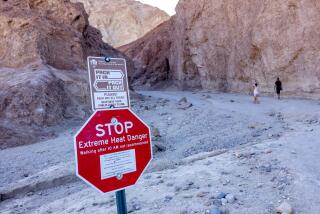Earth sets heat record in 2016 for the third year in a row

According to independent analyses by NASA and the National Oceanic and Atmospheric Administration, the 1.78-degree jump over the mid-20th-century average marks the third year in a row that global temperatures have reached record-shattering levels.
It’s official: 2016 was the hottest year on record since scientists began tracking Earth’s temperature more than 100 years ago, according to independent analyses by NASA and the National Oceanic and Atmospheric Administration.
The 1.69-degree jump over the 20th-century average, according to NOAA, marks the third year in a row that global temperatures have reached record-shattering levels. The National Aeronautics and Space Administration added that the global average temperature for 2016 was 1.78 degrees higher than a baseline period between 1951 and 1980.
Both agencies noted that Earth’s average global temperature — which NOAA pegged at 57 degrees during the 20th century — was higher in 2016 than in any year since scientists began tracking it in 1880.
“For the first time in recorded history, we have now had three consecutive record-warm years,” said Michael Mann, a climate scientist at Pennsylvania State University who was not involved in the findings. “The likelihood of this having happened in the absence of human-caused global warming is minimal.”
The government reports were released Wednesday as President-elect Donald Trump’s nominee to lead the Environmental Protection Agency said he disagreed with the overwhelming scientific consensus that Earth is warming at a catastrophic rate and that human activities are to blame.
“The ability to measure with precision the extent of [human] impact and what to do about it are subject to continued debate and dialogue,” Oklahoma Atty. Gen. Scott Pruitt told senators during his contentious confirmation hearing.
The average global temperature incorporates measurements taken from locations across land and sea, including 6,300 ground-based weather stations, legions of ocean buoys and research facilities in Antarctica.
Those instruments tracked record warm temperatures for eight months of the year. NASA and NOAA agree that January, February, March, April, May, July and August set new records; NOAA’s list also includes July, while NASA’s also includes September.
The global thermostat got a boost during the first part of 2016 thanks to El Niño, a multiyear weather pattern in the equatorial Pacific Ocean that’s driven by temperature fluctuations between the ocean and atmosphere. The slight cooling effect from El Niño’s counterpart, La Niña, in the latter half of the year couldn’t keep 2016 from beating 2015.
The effects of the extra heat were felt across the globe, NOAA said. The temperature in Mitribah, Kuwait, on July 21 reached 129.2 degrees, the highest ever for Asia. In Alberta, Canada, a wildfire burned about 2,400 homes and became the costliest natural disaster in that country’s history. In southern Africa, two years of low rainfall led to serious drought.
Overall, Earth’s average surface temperature has risen about 2 degrees since the late 19th century, scientists with NASA said. The bulk of that increase has come since 1980, and especially since the turn of the century: Of the 17 warmest years on record, 16 occurred since 2001, according to NASA.
Both land and sea temperatures hit new highs in 2016, NOAA said. The surface temperature of the continents was 2.57 degrees above average, and the surface temperature of the oceans was 1.35 degrees above average, NOAA said.
“It was really global warmth that we saw in 2016, even more so than 2015,” said Derek Arndt, chief of the monitoring branch at NOAA’s National Centers for Environmental Information in Asheville, N.C.
The findings were not exactly a surprise: Scientists had predicted that 2016 would be even hotter than the previous year’s record-breaking temperatures, and data through November seemed to be bearing that out.
Since the start of the Industrial Revolution, humans have released unprecedented amounts of carbon dioxide and other heat-trapping greenhouse gases into the atmosphere. The results can be seen around the globe, including higher sea levels, acidic oceans, more extreme weather events and local extinctions of species that haven’t been able to adapt to changes in their ecosystems.
As the oceans warm and more water evaporates, the atmosphere is able to carry more water — which can lead to more severe storms and flooding, said Richard Rood, a climate scientist at the University of Michigan in Ann Arbor.
“Last year was really quite remarkable with regard to floods,” Rood said, pointing to events in Louisiana, the Carolinas and Texas. “Those events strike me as particularly compelling.”
While NOAA and NASA used slightly different methods to calculate global temperature changes, their measurements matched well with each other and with other analyses — including one from the nonprofit climate research group Berkeley Earth, which also called 2016 the hottest year on record.
“These datasets are all singing the same song,” Arndt said. “The pattern is very clear.”
Richard Muller, a UC Berkeley physicist and Berkeley Earth’s co-founder, took issue with the idea that today’s extreme weather events could be directly linked to global warming. He said the real effects would be seen in the future and likely would affect areas with agricultural production — which could lead to geopolitical conflict.
“In my mind, the greatest threat of global warming is war,” he said.
The U.S. experienced 15 weather-related disasters last year, including drought, wildfire, flooding, severe storms and a hurricane, which together resulted in losses of $46 billion and the deaths of 138 people, NOAA said. In addition, 13.1 million Americans living along coastlines are vulnerable to flooding caused by the melting of polar ice reserves, according to a recent study.
The North American continent experienced its warmest year on record, led by rising temperatures in the Arctic. At the northern reaches of the globe, scientists measured an average of 3.92 million square miles of sea ice over the course of 2016, the lowest annual average since their measurements began in 1979, NOAA said.
No other continent broke a record in 2016, but most came close. South America and Africa recorded their second-highest average temperatures, while Europe and Asia had their third-warmest years. Temperatures in Australia were the fifth-highest on record, according to NOAA.
In Antarctica, the amount of sea ice averaged 4.31 million square miles in 2016. That was the second-lowest amount since 1979, NOAA added.
Because La Niña tends to be a cooling trend, scientists do not expect 2017 to break last year’s heat record. But like El Niño, La Niña is a short-term weather pattern, and it cannot stop temperatures from continuing to rise in the long term, researchers said.
Times staff writer Evan Halper in Washington, D.C., contributed to this report.
Follow @aminawrite on Twitter for more science news and “like” Los Angeles Times Science & Health on Facebook.
ALSO
How your racial biases can change in a heartbeat
Using lasers, scientists turn mice into ferociously efficient hunters
This forecasting tool aims to keep ships and blue whales from colliding
UPDATES:
2:55 p.m.: This article was updated with additional comments from climate scientist Richard Rood and physicist Richard Muller.
12:55 p.m.: This article was updated with additional details from NASA and NOAA, as well as with comments from climate scientist Michael Mann.
This article was originally published at 9:05 a.m.







